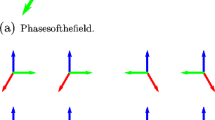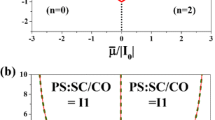Abstract
We continue the discussion of a bipolaronic superconductor (resp. an anisotropic antiferromagnet in quasispin formulation) as formulated in a previous work, based on a quantum-statistical, microscopic mean-field model. The grand-canonical thermodynamic limit is compared with the canonical thermodynamic limit in terms of a net of perturbations, becoming singular in the infinite lattice limit. A generalized thermostatistical framework is elaborated which covers model potentials with infinite parts. The function of the limiting free energy density in selecting the (stable) phases with broken symmetry is graphically illustrated. The phase diagrams for the two types of ensembles are shown to differ in the region where both the gauge symmetry and the invariance under sublattice exchange are broken. In particular, the type of the phase transitions, the order of the critical points, and the shape of some phase boundaries are found to depend on the ensemble, which clarifies certain controversial topics for these models. The uniqueness of the limiting Gibbs states with free boundary conditions in all thermodynamic phase regions is proved, and their decomposition into pure phase states in terms of a symmetric measure is evaluated. The field operators of the condensed particles are determined in the representations over the limiting Gibbs states.
Similar content being viewed by others
REFERENCES
T. Gerisch and A. Rieckers, Limiting gibbs states and phase transitions of a bipartite mean-field hubbard-model, J. Stat. Phys. 91:759 (1998).
S. Robaszkiewicz, R. Micnas, and K. A. Chao, Thermodynamic properties of the extended Hubbard model with strong intra-atomic attraction and an arbitrary electron density, Phys. Rev. B 23:1447–1458 (1981).
A. Alexandrov and J. Ranninger, Theory of bipolarons and bipolaronic bands, Phys. Rev. B 23:1796–1801 (1981).
R. Micnas, J. Ranninger, and S. Robaszkiewicz, Superconductivity in narrow-band systems with local nonretarded attractive interactions, Rev. Mod. Phys. 62:113–171 (1990).
A. S. Alexandrov and N. Mott, Polarons and Bipolarons (World Scientific, Singapore, 1995).
A. D. Bruce and A. Aharony, Coupled order parameters, symmetry-breaking irrelevant scaling fields, and tetracritical points, Phys. Rev. B 11:478–499 (1975).
M. E. Fisher and D. R. Nelson, Spin flop, supersolids, and bicritical and tetracritical points, Phys. Rev. Lett. 32:1350–1353 (1974).
Y. Imry, D. J. Scalapino, and L. Gunther, Phase transitions in systems with coupled order parameters, Phys. Rev. B 10:2900–2902 (1974).
J. M. Kosterlitz, D. R. Nelson, and M. E. Fisher, Bicritical and tetracritical points in anisotropic antiferromagnetic systems, Phys. Rev. B 13:412–432 (1976).
K.-S. Liu and M. E. Fisher, Quantum lattice gas and the existence of a supersolid, J. Low Temp. Phys. 10:655–683 (1973).
R. F. Werner, Large deviations and mean-field quantum systems, In Quantum Probability and Related Topics VII, pp. 349–381 (World Scientific, Singapore, 1992).
R. B. Israel, Convexity in the Theory of Lattice Gases (Princeton University Press, 1979).
T. Gerisch, A. Rieckers, and H.-J. Volkert, Thermodynamic Formalism and Phase Transitions of Generalized Mean-Field Quantum Lattice Models, Z. Naturforsch. 53a:179–207 (1998).
O. Bratteli and D. W. Robinson, Operator Algebras and Quantum Statistical Mechanics, Vol. 1 (Springer-Verlag, 1987).
O. Bratteli and D. W. Robinson, Operator Algebras and Quantum Statistical Mechanics, Vol. II (Springer-Verlag, 1981).
G. L. Sewell, Quantum Theory of Collective Phenomena (Clarendon Press, Oxford, 1986).
S. Sakai, C*-Algebras and W*-Algebras (Springer-Verlag, Berlin, 1971).
E. Størmer, Symmetric states of infinite tensor products of C*-algebras, J. Funct. Anal. 3:48–68 (1969).
T. Gerisch, Internal symmetries and limiting Gibbs states in quantum lattice mean field theories, Physica A 197:284–300 (1993).
W. Fleig, Operatoralgebraische Quantenstatistik von Zusammengesetzten langreichweitigen Gittersystemen, Ph.D. thesis (Dissertation), Universität Tübingen, 1985, unpublished.
M. J. Donald, Relative Hamiltonians which are not bounded from above, J. Funct. Anal. 91:143–173, (1990).
G. A. Raggio and R. F. Werner, Quantum statistical mechanics of general mean field systems, Helv. Phys. Acta 62:980–1003 (1989).
T. Gerisch and A. Rieckers, The quantum statistical free energy minimum principle for multi-lattice mean field theories, Z. Naturforsch. 45a:931–945 (1990).
R. S. Ellis, Entropy, Large Deviations, and Statistical Mechanics (Springer, 1985).
T. Gerisch and A. Rieckers, Comparison of weakly inhomogeneous BCS-and Hubbardmodels, Physica A 242:439–466 (1997).
E. Størmer, Large groups of automorphisms of C*-algebras, Commun. Math. Phys. 5:1–22 (1967).
W. Flcig, On the symmetry breaking mechanism of the strong-coupling BCS-model, Acta Phys. Austr. 55:135–153 (1983).
T. Gerisch and A. Rieckers, Limiting dynamics, KMS-states, and macroscopic phase angle for weakly inhomogeneous BCS-models, Helv. Phys. Acta 70:727–750 (1997).
P. W. Anderson, Coherent matter field phenomena in superfluid, Lectures of Belfer Graduate School of Sciences 2:21–40 (1967).
G. L. Sewell, Macroscopic quantum theoretic approach to superconductive electrodynamics, In Superconductivity and Strongly Correlated Electronic Systems (World Scientific, Singapore, 1994).
C. J. Gorter and T. van Peski-Tinbergen, Transitions and phase diagrams in an orthorhombic antiferromagnetic crystal, Physica 22:273–287 (1956).
G. J. Butterworth and V. S. Zidell, Magnetothermal studies of the phase transitions in CuCl2·2H2O, J. Appl. Phys. Suppl. 40:1033–1034 (1969).
K. W. Blazey, H. Rohrer, and R. Webster, Magnetocaloric effects and the angular variation of the magnetic phase diagram of antiferromagnetic GdAlO3, Phys. Rev. B 4:2287–2302 (1971).
E. Müller-Hartmann and J. Zittartz, Theory of magnetic impurities in superconductors—depression of the transition temperature, Z. Physik 234:58 (1970).
E. Müller-Hartmann and J. Zittartz, Kondo effect in superconductors, Phys Rev. Lett. 26:428 (1971).
S. V. Vonsowsky, Yu. A. Izyumov, and E. Z. Kurmaev, Superconductivity of Transition Metals, Their Alloys and Compounds (Springer, 1982).
N. Plakida, High-Temperature Superconductivity (Springer, Berlin, 1995).
F. Mancini, S. Marra, A. M. Allega, and H. Matsumoto, Mean field analysis of the Hubbard model, Physica C 240:2253–2254 (1994).
F. Mancini, S. Marra, and H. Matsumoto, The two-dimensional t-t′-U Hubbard model as a 1minimal model for cuprate materials, preprint, cond-mat/9707088, 1997.
Author information
Authors and Affiliations
Rights and permissions
About this article
Cite this article
Gerisch, T., Münzner, R. & Rieckers, A. Canonical versus Grand-Canonical Free Energies and Phase Diagrams of a Bipolaronic Superconductor Model. Journal of Statistical Physics 93, 1021–1049 (1998). https://doi.org/10.1023/B:JOSS.0000033152.73539.a2
Issue Date:
DOI: https://doi.org/10.1023/B:JOSS.0000033152.73539.a2




